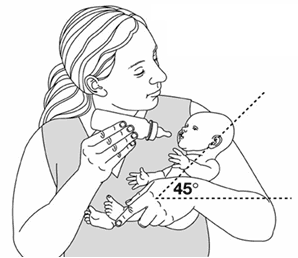Feeding of Children with Clefts
Children with cleft lip and/or palate have a malpositioned muscular group and pathological openings changing the vacuum in the mouth, which leads to different difficulties in feeding, breathing, hearing or speaking. There are untrue statements that children with such abnormalities do not have sucking reflex and cannot be breast-fed. Because of communication between the mouth and the nose, there is an unduly big fear of aspiration. All of this, combined with lack of knowledge about the essence of the problem leads to an incorrect approach in the first cares after birth, related to the nutrition of these children.
Babies with cleft lip and/or palate have more special requirements for feeding, but it does not mean that they can not be fed normally (breast-fed), with special feeding-bottle, droppers, syringes or spoon.
Every mother and every baby are unique, so it is not possible to give hard or fast rules to follow during the feeding. The choice of a suitable and safe method of nutrition should be specified with the help of a specially trained nurse.

The position of the baby during the feeding of children with facial abnormalities is very important. The baby should be half-standing, with well leaning back.When the baby has a cleft palate, the food often escapes through the nose. That can happen not only during feeding, but also when there’s a vomiting. This can cause not only inconvenience, but there is also risk for the baby’s health. Babies with cleft palate often suffer from ear infections caused by the existing communication between ear nose and mouth. That is why the position of the baby during feeding is very important.
Babies with a cleft need to be burped more often because they take in more air while feeding. when the baby feels uncomfortable, stop and give him a burp by massaging the back.
Ways of Feeding Children with Clefts

Breast Feeding
Children with cleft lip only, can be successfully breast-fed. Sometimes, that can be hard to do, but we should not forget, that children without abnormalities may also have difficulties with breastfeeding. The suck has a series of advantages for the development of the facial and mouth muscles, which is quite important for the speech. Babies with cleft palate, who are breastfed, have less infections of the middle ear, than the others. The most important thing is the positive effect of the connection between the mother and the baby, which can not be substituted by bottles or nipples.
Feeding Bottles
Often when the child has a cleft palate and the breast-feeding is not possible, soft feeding-bottle also can be used. The holes of the nipple should not be at the front or the top, they should be positioned laterally. There are special feeding-nipples developed, which can cover the cleft, and also soft bottles, that with occasional squeezes allow the milk flowing out into the mouth. The use of soft bottles is recommended only when the baby has GAG reflex, otherwise there is a risk of aspiration.
Special care should be taken while feeding the baby with bottle. it should be kept in mind that the nipple should not be placed in the cleft side as it can widen the gap.


Spoons
Babies with cleft can be fed with a spoon if they are unable to suck in their early days. Care shoud be taken while feeding with a spoon . The food should not be poured in the middle of the tongue. Using the spoon you should lightly press the tongue, gently turn the spoon and pour the food on the side, to the cheek, outside of the gum. Otherwise there is a risk of aspiration.
Dropper & Syringes
Often when the child has a cleft palate and the breast-feeding is not possible, dropper or syringe also can be used. The holes of the dropper or syringe should not be at the front or the top, they should be positioned laterally.


